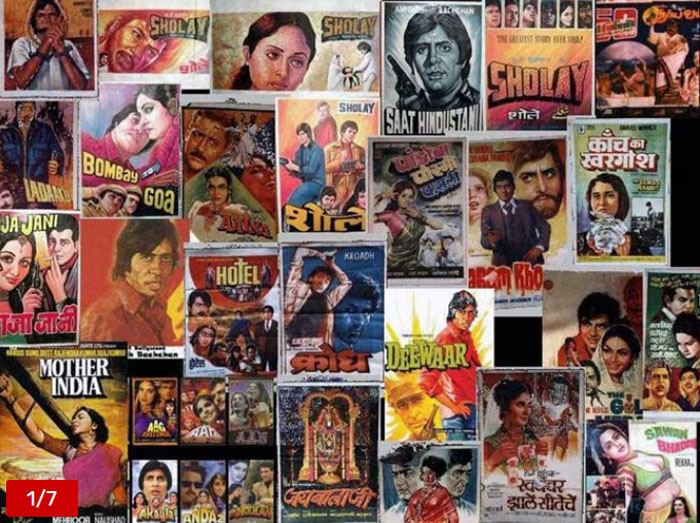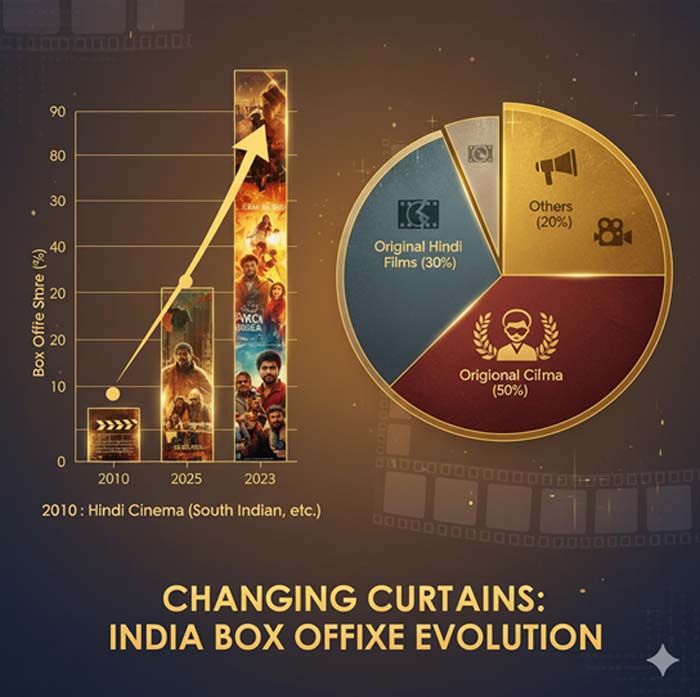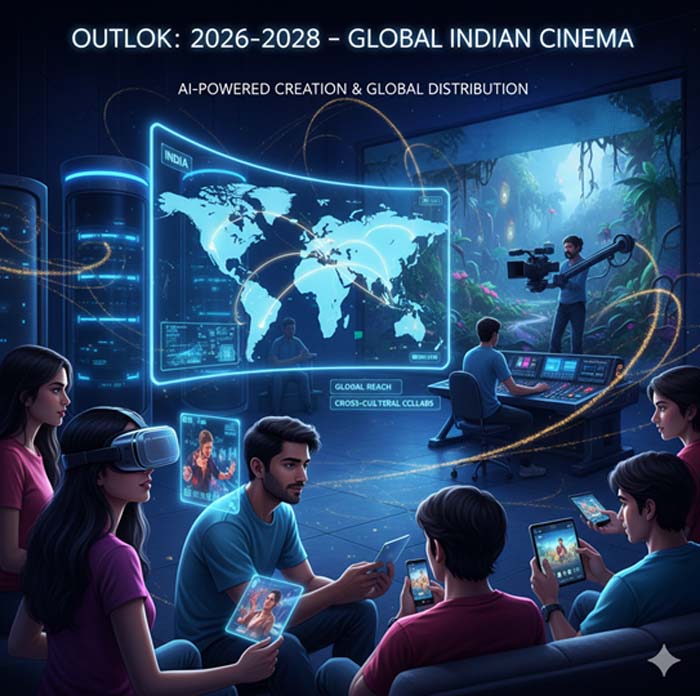A Global Context: India’s Expanding Cinematic Footprint
In the post-pandemic world, few entertainment industries have rebounded as impressively as India’s film sector. Globally, theatrical markets in North America, China, and Europe have either plateaued or witnessed uneven recoveries due to changing streaming habits, production slowdowns, and cost escalations. In contrast, India has emerged as a resilient outlier — not only restoring pre-pandemic box office strength but diversifying its creative and commercial base.

With more than 1,700 feature films produced annually across over 20 languages, India remains the world’s most prolific film-producing nation. The total box office gross of ₹12,226 crore in 2023 placed it among the top three theatrical markets globally, behind only the United States and China, and ahead of major European territories. Beyond the box office, the Indian film ecosystem spanning theatrical, digital, satellite, and overseas markets now represents a multi-billion-dollar cultural economy, influencing entertainment trends across Asia, the Middle East, and the global Indian diaspora. Yet, beneath these headline figures lies a deeper structural transformation, a transformation defined by shifting language dominance, regional creativity, and new consumption behaviours, signaling the emergence of a new cinematic order.
A Historical and Comparative Lens-“Plus ça change, plus c’est la même chose” (the more things change, the more they stay the same) (Jean-Baptiste Alphonse Karr)

Viewed through a historical and comparative lens, India’s all-language box office performance illustrates a decisive phase of transition. The Indian film industry grossed a record of ₹12,226 crore in 2023, symbolizing both recovery and reinvention in the aftermath of the pandemic. In 2024, the total box office gross stood at ₹11,833 crore, only 3% lower, making it the second-best year on record.
This marginal dip reflects stabilization, not stagnation. It marks the consolidation of post-pandemic gains, diversification of regional markets, and evolving audience expectations. The story of Indian cinema today is not one of uniform growth, but of redistributed vitality, where regional cinemas rise even as Bollywood recalibrates its direction.

The Dynamics and Dialectics of Change – Declining Hindi Films, Rising Regional Cinemas
The most striking feature of this morphology of evolution, this transformation, is the shift in linguistic and regional dynamics. For decades, Hindi-language cinema (Bollywood) dominated the national conversation and global perception of Indian film. This dominance is now decisively eroding.
The Hindi film segment (Bollywood originals) saw its box office revenue fall from ₹5,380 crore in 2023 to around ₹4,679 crore in 2024, a contraction exceeding 13%. More revealingly, 31% of the Hindi box office in 2024 came from dubbed South Indian films, primarily Telugu and Tamil blockbusters. Stripping away these dubbed contributions, earnings from original Hindi-language films declined by nearly 37%, highlighting both content fatigue and a disconnect with evolving audience preferences.

By contrast, regional cinemas, especially Malayalam, displayed exceptional dynamism. Malayalam films doubled their national market share from 5% in 2023 to 10% in 2024, crossing the ₹1,000 crore milestone for the first time — a feat unthinkable a decade ago. The Telugu, Tamil, and Kannada industries have also consolidated their pan-India appeal, combining regional authenticity with high production values and strong narratives.
Momentum remained strong through 2025: India’s all-language box office reached ₹5,723 crore in the first half (January–June), a 14% year-on-year increase, and ₹7,175 crore by July, about 22% higher than the same period in 2024. This steady acceleration underscores the fact that India’s cinematic revival is both broad-based and regionally driven.

Surging Theatrical Business – Lexicon of Change for Bollywood
India’s theatrical business in 2025 is robust, reflecting increased audience confidence, higher ticket realization, and deeper market penetration in Tier-2 and Tier-3 cities. Multiplex expansion, digital ticketing, and diversified language programming have all broadened the theatrical base.
Yet, the ripple effects manifested in Bollywood’s persisting challenges remain structural rather than cyclical. The decline in original Hindi blockbusters is symptomatic of creative exhaustion, overproduction, and dependence on outdated formulas. Many high-budget films, heavy on visual spectacle but light on substance, have failed to resonate in an era where audiences prioritize authentic, emotionally grounded storytelling, necessitating course-correction.
Meanwhile, the Southern film industries have pioneered a new creative grammar — merging regional specificity with universal resonance. Productions such as RRR, Jailer, Kantara, Manjummel Boys, and Hi Nanna have demonstrated that a rooted narrative, delivered with technical finesse and emotional sincerity, can achieve pan-India success without linguistic compromise.
For Bollywood, the imperative is clear: reform and rediscover. This means investing in original writing, empowering younger directors, embracing linguistic collaborations, and exploring mid-budget films that balance risk with reward. The reinvention of Hindi cinema will depend less on star power and more on storytelling power marked by love, songs, revenge and action.

Conspicuous Absence of Blockbuster Diwali Hits – No Cause for Concern
The underlying reason for the absence of major Diwali releases in 2025, traditionally the most lucrative box office window, has raised questions about industry momentum. The Latin expression res ipsa loquitur (the thing speaks for itself), which is a doctrine in common law and Roman-Dutch law jurisdictions, suggests that one of the basic reasons for this scenario is not evidence of decline but of strategic realignment.
Several trends explain this shift:
- Production timelines have lengthened due to complex post-production, visual effects, and financing delays.
- Studios are avoiding release clashes, opting for quieter windows that allow longer theatrical runs and stronger word-of-mouth.
- The economics of risk has changed: post-pandemic volatility has made producers more cautious about investing ₹200–300 crore in a single festive gamble.
- Streaming exposure has reshaped viewing cycles; audiences are now more content-driven than calendar-driven.
In short, the muted Diwali lineup reflects a maturing release strategy, not a shrinking market. The era of festival-dominated scheduling is giving way to data-driven release planning, where studios distribute risk and optimize timing across the year. India’s film calendar is flattening — a sign of structural maturity rather than weakness.

Economic and Strategic Logic-A New Cinematic Order in the Making
These cognizable dilemmas and evolving trends collectively signal the rise of a multipolar cinematic ecosystem:
- Cultural power is decentralizing — Regional industries are achieving national recognition and global visibility.
- Audiences are multilingual and cross-platform — They seamlessly consume dubbed, subtitled, or original-language content.
- Storytelling is diversifying — From rooted folklore and social realism to high-concept thrillers and mythological epics, the spectrum is widening.
- Economics is rationalizing — Mid-budget films are proving more profitable and sustainable than overblown spectacles.
- Festivals are de-monopolized — Year-round releases and counterprogramming are replacing traditional holiday clustering.
In effect, India’s cinematic geography is being redrawn. The Mumbai-centric Bollywood model is ceding space to a federal structure of film industries, each region contributing distinct aesthetics, narratives, and identities to the national cinematic fabric.

This transformation is not about the decline of one tradition but the plural renaissance of Indian cinema — energetic, experimental, and regionally inclusive.
Outlook: 2026–2028 – The Next Chapter of Indian Cinema
Disruption is never comfortable. Yet India’s evolving cinematic order – the churn and the swirl, the ferment and the convulsion- is unmistakably evident in the entire ecosystem of filmmaking. Bob Dylan captured this moment of upheaval with prescient clarity more than sixty years ago:
“The line it is drawn
The curse it is cast
The slow one now
Will later be fast…
The order is rapidly fadin’
And the first one now
Will later be last
For the times they are a-changin’”
The message is unambiguous: adapt or be left behind. Time does not pause. To thrive, one must seize it — as William Shakespeare wrote powerfully in his classic work Julius Caesar,
“There is a tide in the affairs of men,
Which taken at the flood, leads on to fortune.
Omitted, all the voyage of their life is bound in shallows and in miseries.
On such a full sea are we now afloat.
And we must take the current when it serves, or lose our ventures”.
The industry must, therefore, act with purpose, think with foresight-there is no soft option today. This is the inescapable rhythm of life and nature.
Looking ahead, the period 2026–2028 promises to be one of technological integration, global outreach, and creative pluralism for Indian cinema. Several converging factors will shape this discourse of innovation:
- Streaming Synergy, Not Competition
The tension between OTT platforms and theatrical releases is likely to settle into a complementary equilibrium. Theatres will remain the preferred medium for large-scale spectacles and event films, while streaming will incubate smaller, experimental projects and provide longer monetization cycles through digital rights. Co-financing models between studios and OTTs are expected to expand, improving risk sharing. - Globalization of Indian Stories
The success of Indian films in international circuits — from RRR’s Oscar recognition to Malayalam films’ global streaming traction — points toward increasing cross-border resonance. India’s soft power will increasingly flow through its regional cinema, aided by global streaming platforms and diaspora demand. Expect greater participation in film festivals, co-productions with Southeast Asia and Europe, and foreign-language remakes. - Investment Realignment
Private equity and corporate studios are likely to rebalance investment toward mid-scale projects with strong scripts, regional backing, and multilingual release potential. The high-risk era of oversized “tentpole” films is waning; the next phase will emphasize content scalability and capital discipline. - Technological Transformation
Virtual production, AI-assisted VFX, and real-time rendering will revolutionize filmmaking efficiency and aesthetics. Smaller studios will gain access to world-class tools, reducing the technological gap between regional and global production standards. - Audience Sophistication and Data Analytics
With rising internet penetration and multiplex growth, Indian audiences are becoming data-literate consumers. Studios will increasingly rely on analytics to forecast demand, customize marketing, and tailor release strategies. Audience segmentation by region, platform, and age will become more precise, influencing greenlighting decisions.
By 2028, India’s film industry could surpass ₹15,000–16,000 crore in annual domestic box office revenues, supported by regional expansion, international markets, and improved production efficiency. Far from being a fragmented space, Indian cinema will evolve into a networked creative ecosystem, interconnected across languages, platforms, and global markets.
Concluding Observations: The Plural Renaissance
The winds of change sweeping through Indian cinema are redefining its creative and commercial DNA. What was once a star-centric, Hindi-dominated industry has become a vibrant, multilingual ecosystem, driven by authenticity, experimentation, and audience empowerment.
India’s cinematic growth semantics today is not merely one of recovery, but of reinvention — a transition from hierarchy to diversity, from formula to freshness, and from spectacle to substance. The coming years will consolidate this plural renaissance, positioning Indian cinema as not just a national industry but a global creative force — confident, connected, and endlessly adaptive.
ABOUT THE AUTHOR
 Dr. Manoranjan Sharma is Chief Economist, Infomerics, India. With a brilliant academic record, he has over 250 publications and six books. His views have been cited in the Associated Press, New York; Dow Jones, New York; International Herald Tribune, New York; Wall Street Journal, New York.
Dr. Manoranjan Sharma is Chief Economist, Infomerics, India. With a brilliant academic record, he has over 250 publications and six books. His views have been cited in the Associated Press, New York; Dow Jones, New York; International Herald Tribune, New York; Wall Street Journal, New York.








